Analysis of Operations, Logistics, and Supply Chain at Ford Motors
VerifiedAdded on 2020/10/22
|10
|2964
|133
Essay
AI Summary
This essay analyzes Ford Motor Company's approach to operations, logistics, and supply chain management, with a focus on new product development and quality management. It examines how Ford integrates quality management, including Total Quality Management (TQM), to meet customer expectations and continuously improve its products. The essay explores the new product development process, from idea generation to commercialization, and highlights the tools and strategies used, such as design and management tools. Furthermore, it discusses the economic, social, and environmental factors that influence Ford's operations, emphasizing the company's commitment to innovation, research and development, and adaptation to market changes. The analysis also covers the tools used in quality management within the automotive industry, such as control plans and failure mode effect analysis. The essay concludes by addressing the critiques of the new product development process and the measures Ford takes to ensure quality and customer satisfaction.
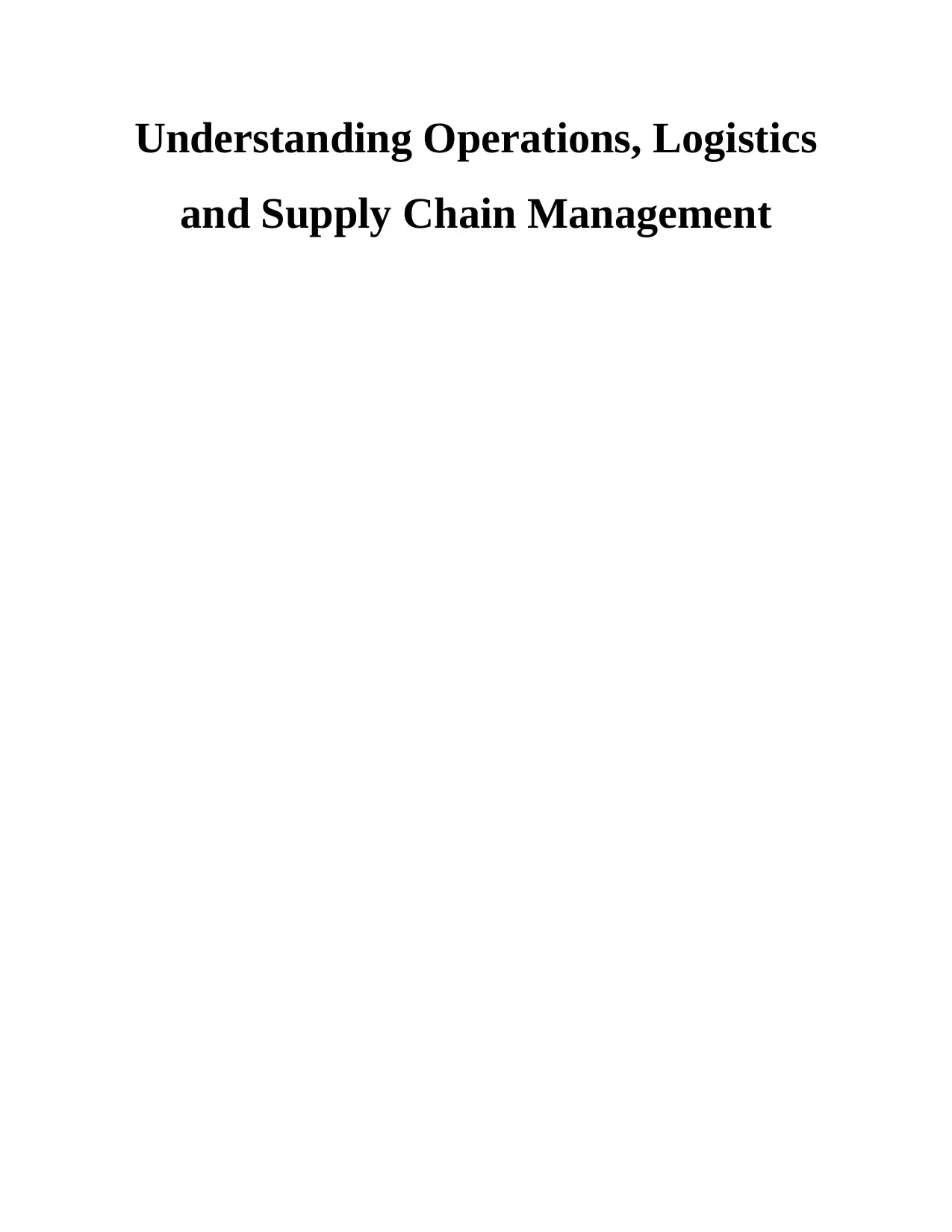
Understanding Operations, Logistics
and Supply Chain Management
and Supply Chain Management
Paraphrase This Document
Need a fresh take? Get an instant paraphrase of this document with our AI Paraphraser

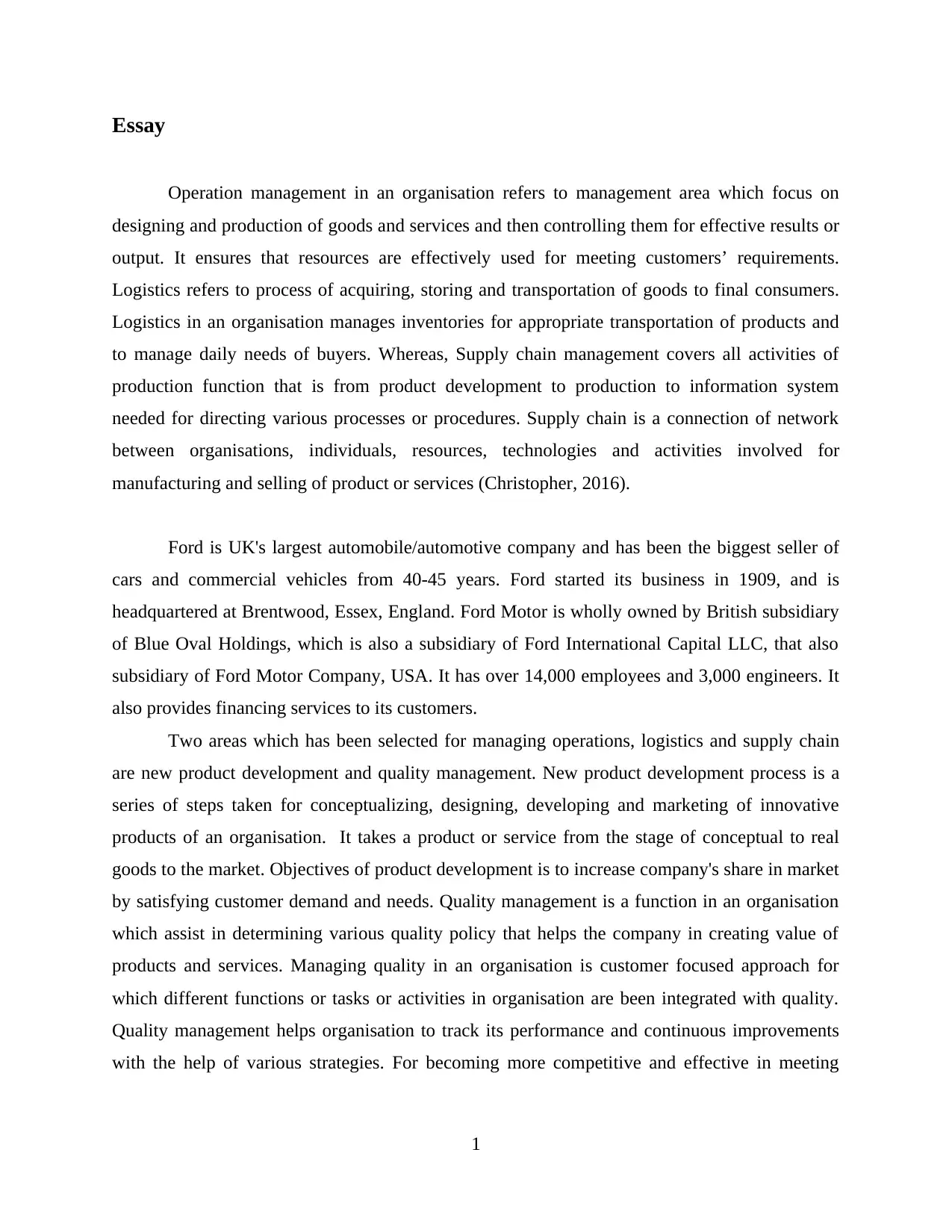
Essay
Operation management in an organisation refers to management area which focus on
designing and production of goods and services and then controlling them for effective results or
output. It ensures that resources are effectively used for meeting customers’ requirements.
Logistics refers to process of acquiring, storing and transportation of goods to final consumers.
Logistics in an organisation manages inventories for appropriate transportation of products and
to manage daily needs of buyers. Whereas, Supply chain management covers all activities of
production function that is from product development to production to information system
needed for directing various processes or procedures. Supply chain is a connection of network
between organisations, individuals, resources, technologies and activities involved for
manufacturing and selling of product or services (Christopher, 2016).
Ford is UK's largest automobile/automotive company and has been the biggest seller of
cars and commercial vehicles from 40-45 years. Ford started its business in 1909, and is
headquartered at Brentwood, Essex, England. Ford Motor is wholly owned by British subsidiary
of Blue Oval Holdings, which is also a subsidiary of Ford International Capital LLC, that also
subsidiary of Ford Motor Company, USA. It has over 14,000 employees and 3,000 engineers. It
also provides financing services to its customers.
Two areas which has been selected for managing operations, logistics and supply chain
are new product development and quality management. New product development process is a
series of steps taken for conceptualizing, designing, developing and marketing of innovative
products of an organisation. It takes a product or service from the stage of conceptual to real
goods to the market. Objectives of product development is to increase company's share in market
by satisfying customer demand and needs. Quality management is a function in an organisation
which assist in determining various quality policy that helps the company in creating value of
products and services. Managing quality in an organisation is customer focused approach for
which different functions or tasks or activities in organisation are been integrated with quality.
Quality management helps organisation to track its performance and continuous improvements
with the help of various strategies. For becoming more competitive and effective in meeting
1
Operation management in an organisation refers to management area which focus on
designing and production of goods and services and then controlling them for effective results or
output. It ensures that resources are effectively used for meeting customers’ requirements.
Logistics refers to process of acquiring, storing and transportation of goods to final consumers.
Logistics in an organisation manages inventories for appropriate transportation of products and
to manage daily needs of buyers. Whereas, Supply chain management covers all activities of
production function that is from product development to production to information system
needed for directing various processes or procedures. Supply chain is a connection of network
between organisations, individuals, resources, technologies and activities involved for
manufacturing and selling of product or services (Christopher, 2016).
Ford is UK's largest automobile/automotive company and has been the biggest seller of
cars and commercial vehicles from 40-45 years. Ford started its business in 1909, and is
headquartered at Brentwood, Essex, England. Ford Motor is wholly owned by British subsidiary
of Blue Oval Holdings, which is also a subsidiary of Ford International Capital LLC, that also
subsidiary of Ford Motor Company, USA. It has over 14,000 employees and 3,000 engineers. It
also provides financing services to its customers.
Two areas which has been selected for managing operations, logistics and supply chain
are new product development and quality management. New product development process is a
series of steps taken for conceptualizing, designing, developing and marketing of innovative
products of an organisation. It takes a product or service from the stage of conceptual to real
goods to the market. Objectives of product development is to increase company's share in market
by satisfying customer demand and needs. Quality management is a function in an organisation
which assist in determining various quality policy that helps the company in creating value of
products and services. Managing quality in an organisation is customer focused approach for
which different functions or tasks or activities in organisation are been integrated with quality.
Quality management helps organisation to track its performance and continuous improvements
with the help of various strategies. For becoming more competitive and effective in meeting
1
⊘ This is a preview!⊘
Do you want full access?
Subscribe today to unlock all pages.

Trusted by 1+ million students worldwide
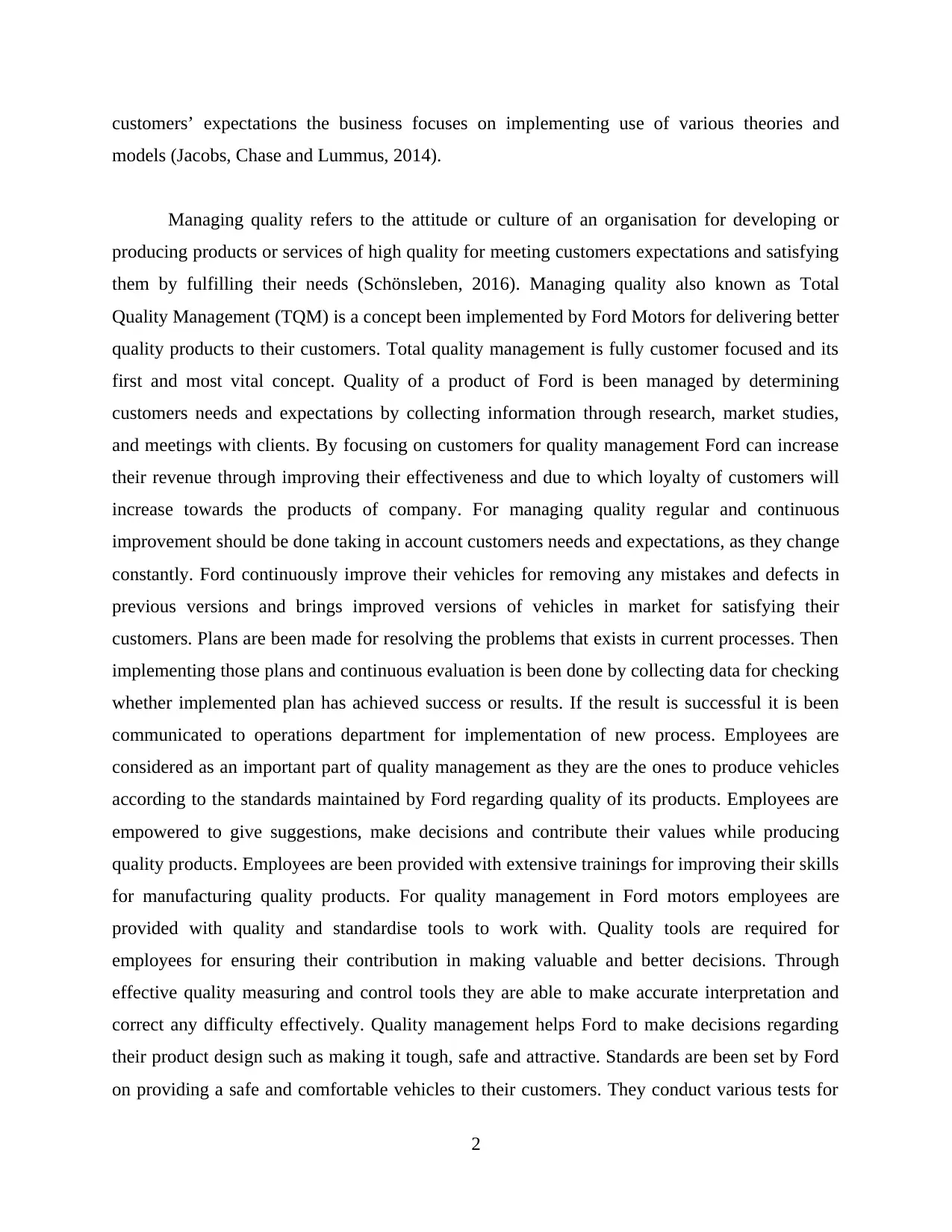
customers’ expectations the business focuses on implementing use of various theories and
models (Jacobs, Chase and Lummus, 2014).
Managing quality refers to the attitude or culture of an organisation for developing or
producing products or services of high quality for meeting customers expectations and satisfying
them by fulfilling their needs (Schönsleben, 2016). Managing quality also known as Total
Quality Management (TQM) is a concept been implemented by Ford Motors for delivering better
quality products to their customers. Total quality management is fully customer focused and its
first and most vital concept. Quality of a product of Ford is been managed by determining
customers needs and expectations by collecting information through research, market studies,
and meetings with clients. By focusing on customers for quality management Ford can increase
their revenue through improving their effectiveness and due to which loyalty of customers will
increase towards the products of company. For managing quality regular and continuous
improvement should be done taking in account customers needs and expectations, as they change
constantly. Ford continuously improve their vehicles for removing any mistakes and defects in
previous versions and brings improved versions of vehicles in market for satisfying their
customers. Plans are been made for resolving the problems that exists in current processes. Then
implementing those plans and continuous evaluation is been done by collecting data for checking
whether implemented plan has achieved success or results. If the result is successful it is been
communicated to operations department for implementation of new process. Employees are
considered as an important part of quality management as they are the ones to produce vehicles
according to the standards maintained by Ford regarding quality of its products. Employees are
empowered to give suggestions, make decisions and contribute their values while producing
quality products. Employees are been provided with extensive trainings for improving their skills
for manufacturing quality products. For quality management in Ford motors employees are
provided with quality and standardise tools to work with. Quality tools are required for
employees for ensuring their contribution in making valuable and better decisions. Through
effective quality measuring and control tools they are able to make accurate interpretation and
correct any difficulty effectively. Quality management helps Ford to make decisions regarding
their product design such as making it tough, safe and attractive. Standards are been set by Ford
on providing a safe and comfortable vehicles to their customers. They conduct various tests for
2
models (Jacobs, Chase and Lummus, 2014).
Managing quality refers to the attitude or culture of an organisation for developing or
producing products or services of high quality for meeting customers expectations and satisfying
them by fulfilling their needs (Schönsleben, 2016). Managing quality also known as Total
Quality Management (TQM) is a concept been implemented by Ford Motors for delivering better
quality products to their customers. Total quality management is fully customer focused and its
first and most vital concept. Quality of a product of Ford is been managed by determining
customers needs and expectations by collecting information through research, market studies,
and meetings with clients. By focusing on customers for quality management Ford can increase
their revenue through improving their effectiveness and due to which loyalty of customers will
increase towards the products of company. For managing quality regular and continuous
improvement should be done taking in account customers needs and expectations, as they change
constantly. Ford continuously improve their vehicles for removing any mistakes and defects in
previous versions and brings improved versions of vehicles in market for satisfying their
customers. Plans are been made for resolving the problems that exists in current processes. Then
implementing those plans and continuous evaluation is been done by collecting data for checking
whether implemented plan has achieved success or results. If the result is successful it is been
communicated to operations department for implementation of new process. Employees are
considered as an important part of quality management as they are the ones to produce vehicles
according to the standards maintained by Ford regarding quality of its products. Employees are
empowered to give suggestions, make decisions and contribute their values while producing
quality products. Employees are been provided with extensive trainings for improving their skills
for manufacturing quality products. For quality management in Ford motors employees are
provided with quality and standardise tools to work with. Quality tools are required for
employees for ensuring their contribution in making valuable and better decisions. Through
effective quality measuring and control tools they are able to make accurate interpretation and
correct any difficulty effectively. Quality management helps Ford to make decisions regarding
their product design such as making it tough, safe and attractive. Standards are been set by Ford
on providing a safe and comfortable vehicles to their customers. They conduct various tests for
2
Paraphrase This Document
Need a fresh take? Get an instant paraphrase of this document with our AI Paraphraser
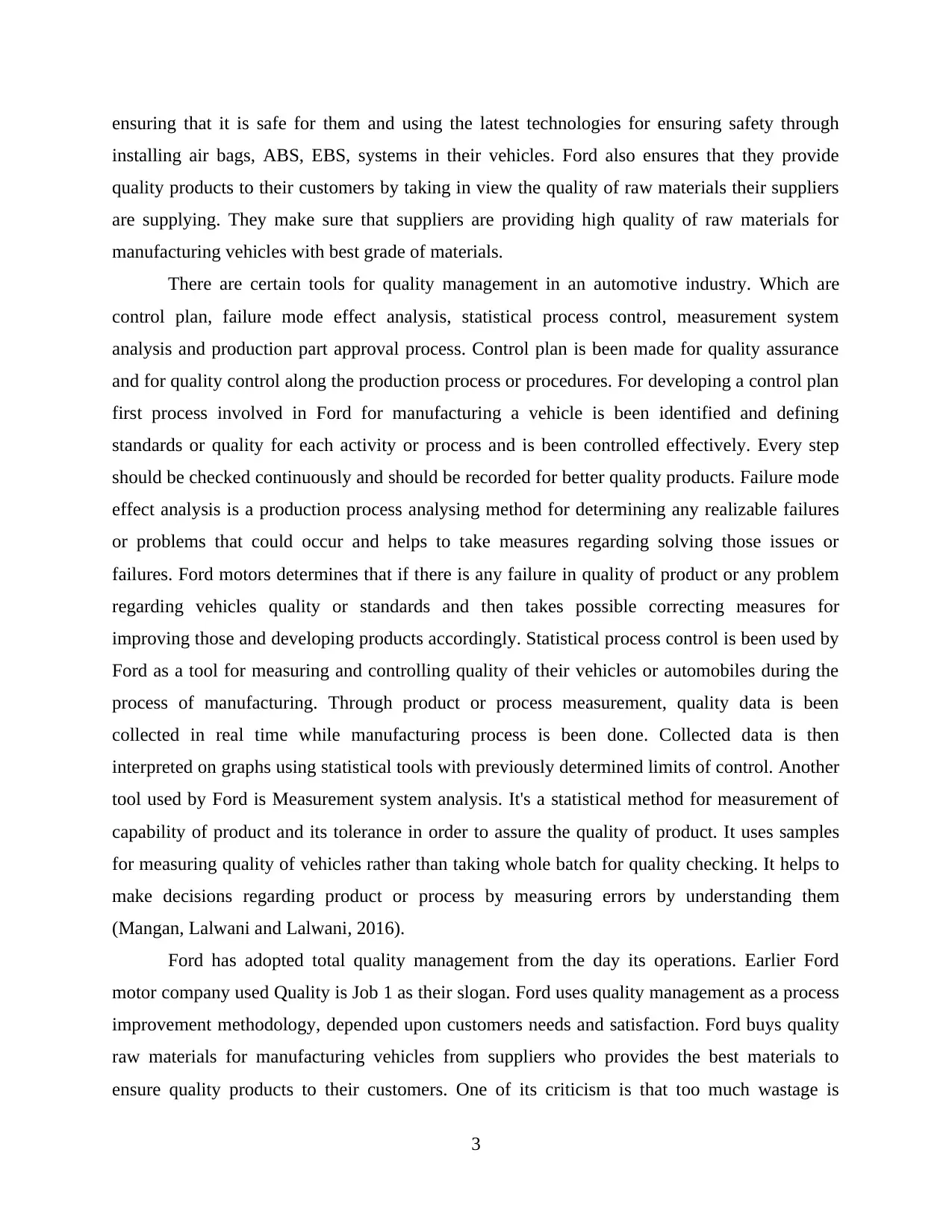
ensuring that it is safe for them and using the latest technologies for ensuring safety through
installing air bags, ABS, EBS, systems in their vehicles. Ford also ensures that they provide
quality products to their customers by taking in view the quality of raw materials their suppliers
are supplying. They make sure that suppliers are providing high quality of raw materials for
manufacturing vehicles with best grade of materials.
There are certain tools for quality management in an automotive industry. Which are
control plan, failure mode effect analysis, statistical process control, measurement system
analysis and production part approval process. Control plan is been made for quality assurance
and for quality control along the production process or procedures. For developing a control plan
first process involved in Ford for manufacturing a vehicle is been identified and defining
standards or quality for each activity or process and is been controlled effectively. Every step
should be checked continuously and should be recorded for better quality products. Failure mode
effect analysis is a production process analysing method for determining any realizable failures
or problems that could occur and helps to take measures regarding solving those issues or
failures. Ford motors determines that if there is any failure in quality of product or any problem
regarding vehicles quality or standards and then takes possible correcting measures for
improving those and developing products accordingly. Statistical process control is been used by
Ford as a tool for measuring and controlling quality of their vehicles or automobiles during the
process of manufacturing. Through product or process measurement, quality data is been
collected in real time while manufacturing process is been done. Collected data is then
interpreted on graphs using statistical tools with previously determined limits of control. Another
tool used by Ford is Measurement system analysis. It's a statistical method for measurement of
capability of product and its tolerance in order to assure the quality of product. It uses samples
for measuring quality of vehicles rather than taking whole batch for quality checking. It helps to
make decisions regarding product or process by measuring errors by understanding them
(Mangan, Lalwani and Lalwani, 2016).
Ford has adopted total quality management from the day its operations. Earlier Ford
motor company used Quality is Job 1 as their slogan. Ford uses quality management as a process
improvement methodology, depended upon customers needs and satisfaction. Ford buys quality
raw materials for manufacturing vehicles from suppliers who provides the best materials to
ensure quality products to their customers. One of its criticism is that too much wastage is
3
installing air bags, ABS, EBS, systems in their vehicles. Ford also ensures that they provide
quality products to their customers by taking in view the quality of raw materials their suppliers
are supplying. They make sure that suppliers are providing high quality of raw materials for
manufacturing vehicles with best grade of materials.
There are certain tools for quality management in an automotive industry. Which are
control plan, failure mode effect analysis, statistical process control, measurement system
analysis and production part approval process. Control plan is been made for quality assurance
and for quality control along the production process or procedures. For developing a control plan
first process involved in Ford for manufacturing a vehicle is been identified and defining
standards or quality for each activity or process and is been controlled effectively. Every step
should be checked continuously and should be recorded for better quality products. Failure mode
effect analysis is a production process analysing method for determining any realizable failures
or problems that could occur and helps to take measures regarding solving those issues or
failures. Ford motors determines that if there is any failure in quality of product or any problem
regarding vehicles quality or standards and then takes possible correcting measures for
improving those and developing products accordingly. Statistical process control is been used by
Ford as a tool for measuring and controlling quality of their vehicles or automobiles during the
process of manufacturing. Through product or process measurement, quality data is been
collected in real time while manufacturing process is been done. Collected data is then
interpreted on graphs using statistical tools with previously determined limits of control. Another
tool used by Ford is Measurement system analysis. It's a statistical method for measurement of
capability of product and its tolerance in order to assure the quality of product. It uses samples
for measuring quality of vehicles rather than taking whole batch for quality checking. It helps to
make decisions regarding product or process by measuring errors by understanding them
(Mangan, Lalwani and Lalwani, 2016).
Ford has adopted total quality management from the day its operations. Earlier Ford
motor company used Quality is Job 1 as their slogan. Ford uses quality management as a process
improvement methodology, depended upon customers needs and satisfaction. Ford buys quality
raw materials for manufacturing vehicles from suppliers who provides the best materials to
ensure quality products to their customers. One of its criticism is that too much wastage is
3
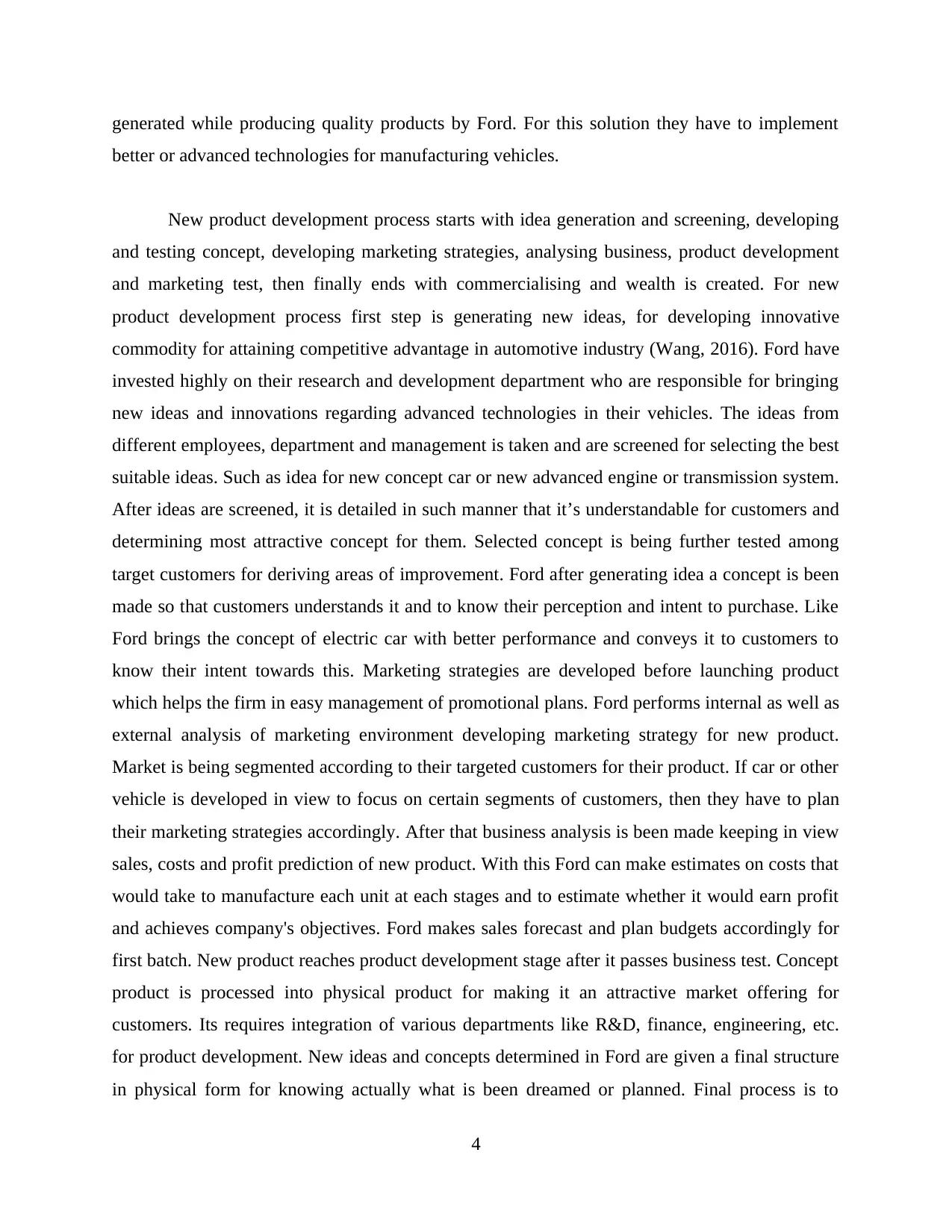
generated while producing quality products by Ford. For this solution they have to implement
better or advanced technologies for manufacturing vehicles.
New product development process starts with idea generation and screening, developing
and testing concept, developing marketing strategies, analysing business, product development
and marketing test, then finally ends with commercialising and wealth is created. For new
product development process first step is generating new ideas, for developing innovative
commodity for attaining competitive advantage in automotive industry (Wang, 2016). Ford have
invested highly on their research and development department who are responsible for bringing
new ideas and innovations regarding advanced technologies in their vehicles. The ideas from
different employees, department and management is taken and are screened for selecting the best
suitable ideas. Such as idea for new concept car or new advanced engine or transmission system.
After ideas are screened, it is detailed in such manner that it’s understandable for customers and
determining most attractive concept for them. Selected concept is being further tested among
target customers for deriving areas of improvement. Ford after generating idea a concept is been
made so that customers understands it and to know their perception and intent to purchase. Like
Ford brings the concept of electric car with better performance and conveys it to customers to
know their intent towards this. Marketing strategies are developed before launching product
which helps the firm in easy management of promotional plans. Ford performs internal as well as
external analysis of marketing environment developing marketing strategy for new product.
Market is being segmented according to their targeted customers for their product. If car or other
vehicle is developed in view to focus on certain segments of customers, then they have to plan
their marketing strategies accordingly. After that business analysis is been made keeping in view
sales, costs and profit prediction of new product. With this Ford can make estimates on costs that
would take to manufacture each unit at each stages and to estimate whether it would earn profit
and achieves company's objectives. Ford makes sales forecast and plan budgets accordingly for
first batch. New product reaches product development stage after it passes business test. Concept
product is processed into physical product for making it an attractive market offering for
customers. Its requires integration of various departments like R&D, finance, engineering, etc.
for product development. New ideas and concepts determined in Ford are given a final structure
in physical form for knowing actually what is been dreamed or planned. Final process is to
4
better or advanced technologies for manufacturing vehicles.
New product development process starts with idea generation and screening, developing
and testing concept, developing marketing strategies, analysing business, product development
and marketing test, then finally ends with commercialising and wealth is created. For new
product development process first step is generating new ideas, for developing innovative
commodity for attaining competitive advantage in automotive industry (Wang, 2016). Ford have
invested highly on their research and development department who are responsible for bringing
new ideas and innovations regarding advanced technologies in their vehicles. The ideas from
different employees, department and management is taken and are screened for selecting the best
suitable ideas. Such as idea for new concept car or new advanced engine or transmission system.
After ideas are screened, it is detailed in such manner that it’s understandable for customers and
determining most attractive concept for them. Selected concept is being further tested among
target customers for deriving areas of improvement. Ford after generating idea a concept is been
made so that customers understands it and to know their perception and intent to purchase. Like
Ford brings the concept of electric car with better performance and conveys it to customers to
know their intent towards this. Marketing strategies are developed before launching product
which helps the firm in easy management of promotional plans. Ford performs internal as well as
external analysis of marketing environment developing marketing strategy for new product.
Market is being segmented according to their targeted customers for their product. If car or other
vehicle is developed in view to focus on certain segments of customers, then they have to plan
their marketing strategies accordingly. After that business analysis is been made keeping in view
sales, costs and profit prediction of new product. With this Ford can make estimates on costs that
would take to manufacture each unit at each stages and to estimate whether it would earn profit
and achieves company's objectives. Ford makes sales forecast and plan budgets accordingly for
first batch. New product reaches product development stage after it passes business test. Concept
product is processed into physical product for making it an attractive market offering for
customers. Its requires integration of various departments like R&D, finance, engineering, etc.
for product development. New ideas and concepts determined in Ford are given a final structure
in physical form for knowing actually what is been dreamed or planned. Final process is to
4
⊘ This is a preview!⊘
Do you want full access?
Subscribe today to unlock all pages.

Trusted by 1+ million students worldwide
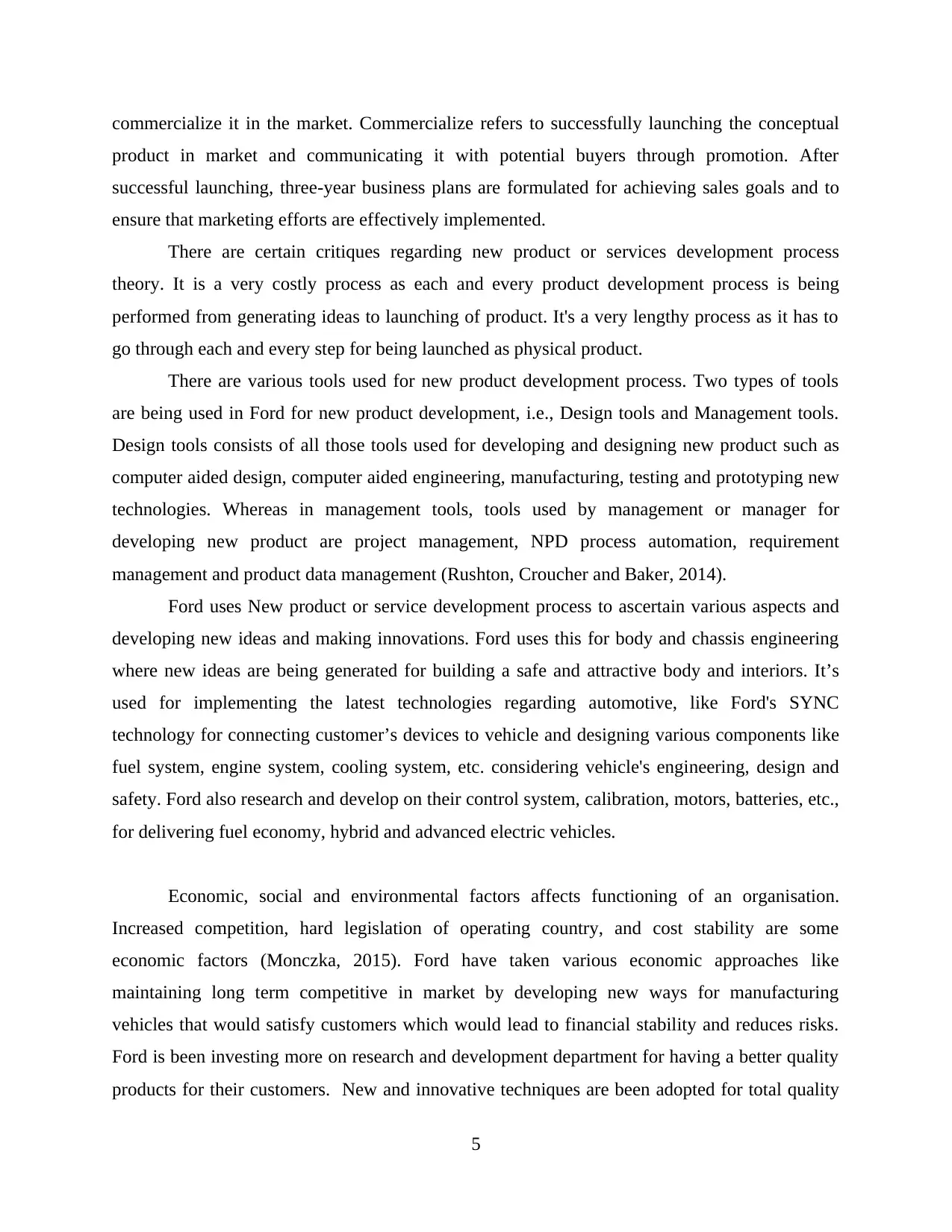
commercialize it in the market. Commercialize refers to successfully launching the conceptual
product in market and communicating it with potential buyers through promotion. After
successful launching, three-year business plans are formulated for achieving sales goals and to
ensure that marketing efforts are effectively implemented.
There are certain critiques regarding new product or services development process
theory. It is a very costly process as each and every product development process is being
performed from generating ideas to launching of product. It's a very lengthy process as it has to
go through each and every step for being launched as physical product.
There are various tools used for new product development process. Two types of tools
are being used in Ford for new product development, i.e., Design tools and Management tools.
Design tools consists of all those tools used for developing and designing new product such as
computer aided design, computer aided engineering, manufacturing, testing and prototyping new
technologies. Whereas in management tools, tools used by management or manager for
developing new product are project management, NPD process automation, requirement
management and product data management (Rushton, Croucher and Baker, 2014).
Ford uses New product or service development process to ascertain various aspects and
developing new ideas and making innovations. Ford uses this for body and chassis engineering
where new ideas are being generated for building a safe and attractive body and interiors. It’s
used for implementing the latest technologies regarding automotive, like Ford's SYNC
technology for connecting customer’s devices to vehicle and designing various components like
fuel system, engine system, cooling system, etc. considering vehicle's engineering, design and
safety. Ford also research and develop on their control system, calibration, motors, batteries, etc.,
for delivering fuel economy, hybrid and advanced electric vehicles.
Economic, social and environmental factors affects functioning of an organisation.
Increased competition, hard legislation of operating country, and cost stability are some
economic factors (Monczka, 2015). Ford have taken various economic approaches like
maintaining long term competitive in market by developing new ways for manufacturing
vehicles that would satisfy customers which would lead to financial stability and reduces risks.
Ford is been investing more on research and development department for having a better quality
products for their customers. New and innovative techniques are been adopted for total quality
5
product in market and communicating it with potential buyers through promotion. After
successful launching, three-year business plans are formulated for achieving sales goals and to
ensure that marketing efforts are effectively implemented.
There are certain critiques regarding new product or services development process
theory. It is a very costly process as each and every product development process is being
performed from generating ideas to launching of product. It's a very lengthy process as it has to
go through each and every step for being launched as physical product.
There are various tools used for new product development process. Two types of tools
are being used in Ford for new product development, i.e., Design tools and Management tools.
Design tools consists of all those tools used for developing and designing new product such as
computer aided design, computer aided engineering, manufacturing, testing and prototyping new
technologies. Whereas in management tools, tools used by management or manager for
developing new product are project management, NPD process automation, requirement
management and product data management (Rushton, Croucher and Baker, 2014).
Ford uses New product or service development process to ascertain various aspects and
developing new ideas and making innovations. Ford uses this for body and chassis engineering
where new ideas are being generated for building a safe and attractive body and interiors. It’s
used for implementing the latest technologies regarding automotive, like Ford's SYNC
technology for connecting customer’s devices to vehicle and designing various components like
fuel system, engine system, cooling system, etc. considering vehicle's engineering, design and
safety. Ford also research and develop on their control system, calibration, motors, batteries, etc.,
for delivering fuel economy, hybrid and advanced electric vehicles.
Economic, social and environmental factors affects functioning of an organisation.
Increased competition, hard legislation of operating country, and cost stability are some
economic factors (Monczka, 2015). Ford have taken various economic approaches like
maintaining long term competitive in market by developing new ways for manufacturing
vehicles that would satisfy customers which would lead to financial stability and reduces risks.
Ford is been investing more on research and development department for having a better quality
products for their customers. New and innovative techniques are been adopted for total quality
5
Paraphrase This Document
Need a fresh take? Get an instant paraphrase of this document with our AI Paraphraser
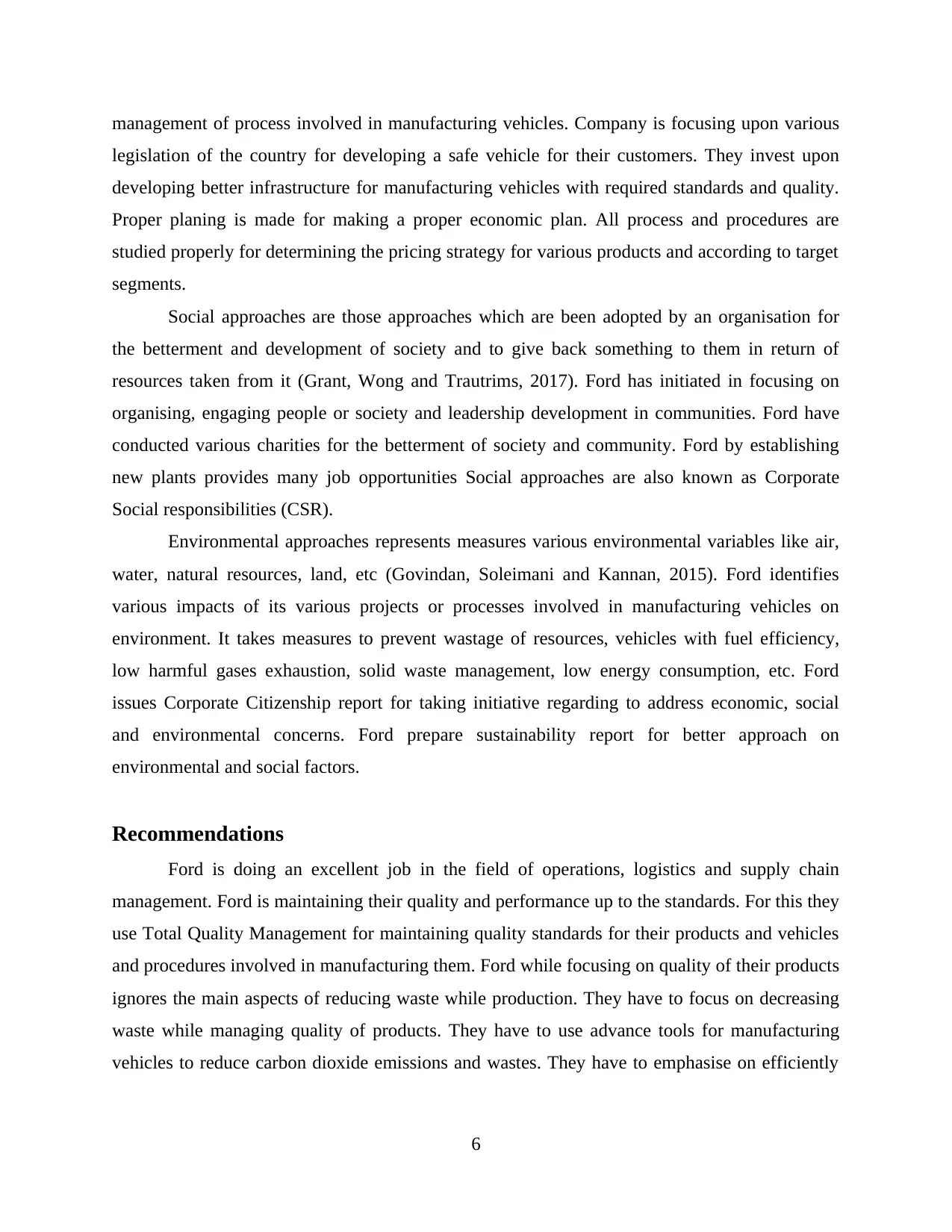
management of process involved in manufacturing vehicles. Company is focusing upon various
legislation of the country for developing a safe vehicle for their customers. They invest upon
developing better infrastructure for manufacturing vehicles with required standards and quality.
Proper planing is made for making a proper economic plan. All process and procedures are
studied properly for determining the pricing strategy for various products and according to target
segments.
Social approaches are those approaches which are been adopted by an organisation for
the betterment and development of society and to give back something to them in return of
resources taken from it (Grant, Wong and Trautrims, 2017). Ford has initiated in focusing on
organising, engaging people or society and leadership development in communities. Ford have
conducted various charities for the betterment of society and community. Ford by establishing
new plants provides many job opportunities Social approaches are also known as Corporate
Social responsibilities (CSR).
Environmental approaches represents measures various environmental variables like air,
water, natural resources, land, etc (Govindan, Soleimani and Kannan, 2015). Ford identifies
various impacts of its various projects or processes involved in manufacturing vehicles on
environment. It takes measures to prevent wastage of resources, vehicles with fuel efficiency,
low harmful gases exhaustion, solid waste management, low energy consumption, etc. Ford
issues Corporate Citizenship report for taking initiative regarding to address economic, social
and environmental concerns. Ford prepare sustainability report for better approach on
environmental and social factors.
Recommendations
Ford is doing an excellent job in the field of operations, logistics and supply chain
management. Ford is maintaining their quality and performance up to the standards. For this they
use Total Quality Management for maintaining quality standards for their products and vehicles
and procedures involved in manufacturing them. Ford while focusing on quality of their products
ignores the main aspects of reducing waste while production. They have to focus on decreasing
waste while managing quality of products. They have to use advance tools for manufacturing
vehicles to reduce carbon dioxide emissions and wastes. They have to emphasise on efficiently
6
legislation of the country for developing a safe vehicle for their customers. They invest upon
developing better infrastructure for manufacturing vehicles with required standards and quality.
Proper planing is made for making a proper economic plan. All process and procedures are
studied properly for determining the pricing strategy for various products and according to target
segments.
Social approaches are those approaches which are been adopted by an organisation for
the betterment and development of society and to give back something to them in return of
resources taken from it (Grant, Wong and Trautrims, 2017). Ford has initiated in focusing on
organising, engaging people or society and leadership development in communities. Ford have
conducted various charities for the betterment of society and community. Ford by establishing
new plants provides many job opportunities Social approaches are also known as Corporate
Social responsibilities (CSR).
Environmental approaches represents measures various environmental variables like air,
water, natural resources, land, etc (Govindan, Soleimani and Kannan, 2015). Ford identifies
various impacts of its various projects or processes involved in manufacturing vehicles on
environment. It takes measures to prevent wastage of resources, vehicles with fuel efficiency,
low harmful gases exhaustion, solid waste management, low energy consumption, etc. Ford
issues Corporate Citizenship report for taking initiative regarding to address economic, social
and environmental concerns. Ford prepare sustainability report for better approach on
environmental and social factors.
Recommendations
Ford is doing an excellent job in the field of operations, logistics and supply chain
management. Ford is maintaining their quality and performance up to the standards. For this they
use Total Quality Management for maintaining quality standards for their products and vehicles
and procedures involved in manufacturing them. Ford while focusing on quality of their products
ignores the main aspects of reducing waste while production. They have to focus on decreasing
waste while managing quality of products. They have to use advance tools for manufacturing
vehicles to reduce carbon dioxide emissions and wastes. They have to emphasise on efficiently
6
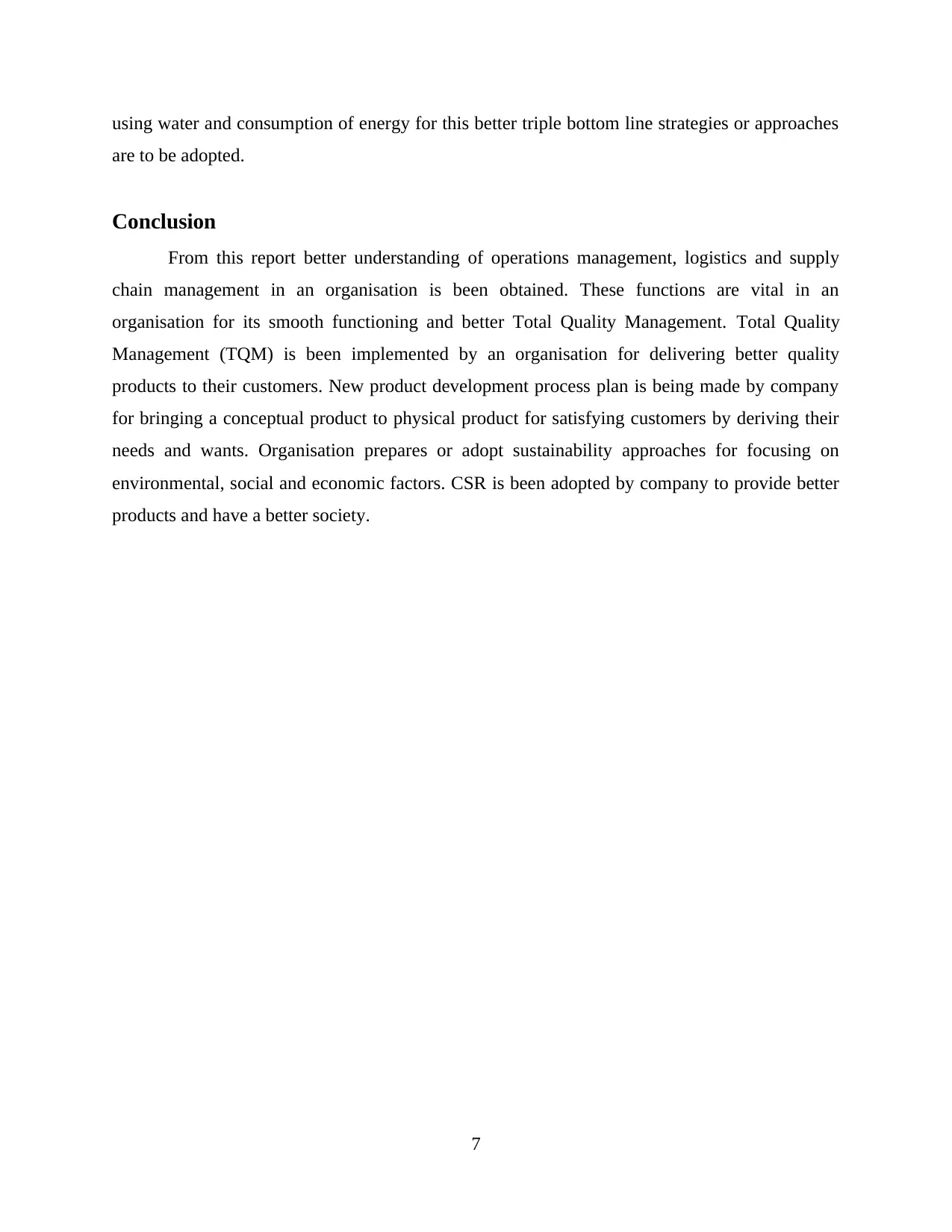
using water and consumption of energy for this better triple bottom line strategies or approaches
are to be adopted.
Conclusion
From this report better understanding of operations management, logistics and supply
chain management in an organisation is been obtained. These functions are vital in an
organisation for its smooth functioning and better Total Quality Management. Total Quality
Management (TQM) is been implemented by an organisation for delivering better quality
products to their customers. New product development process plan is being made by company
for bringing a conceptual product to physical product for satisfying customers by deriving their
needs and wants. Organisation prepares or adopt sustainability approaches for focusing on
environmental, social and economic factors. CSR is been adopted by company to provide better
products and have a better society.
7
are to be adopted.
Conclusion
From this report better understanding of operations management, logistics and supply
chain management in an organisation is been obtained. These functions are vital in an
organisation for its smooth functioning and better Total Quality Management. Total Quality
Management (TQM) is been implemented by an organisation for delivering better quality
products to their customers. New product development process plan is being made by company
for bringing a conceptual product to physical product for satisfying customers by deriving their
needs and wants. Organisation prepares or adopt sustainability approaches for focusing on
environmental, social and economic factors. CSR is been adopted by company to provide better
products and have a better society.
7
⊘ This is a preview!⊘
Do you want full access?
Subscribe today to unlock all pages.

Trusted by 1+ million students worldwide
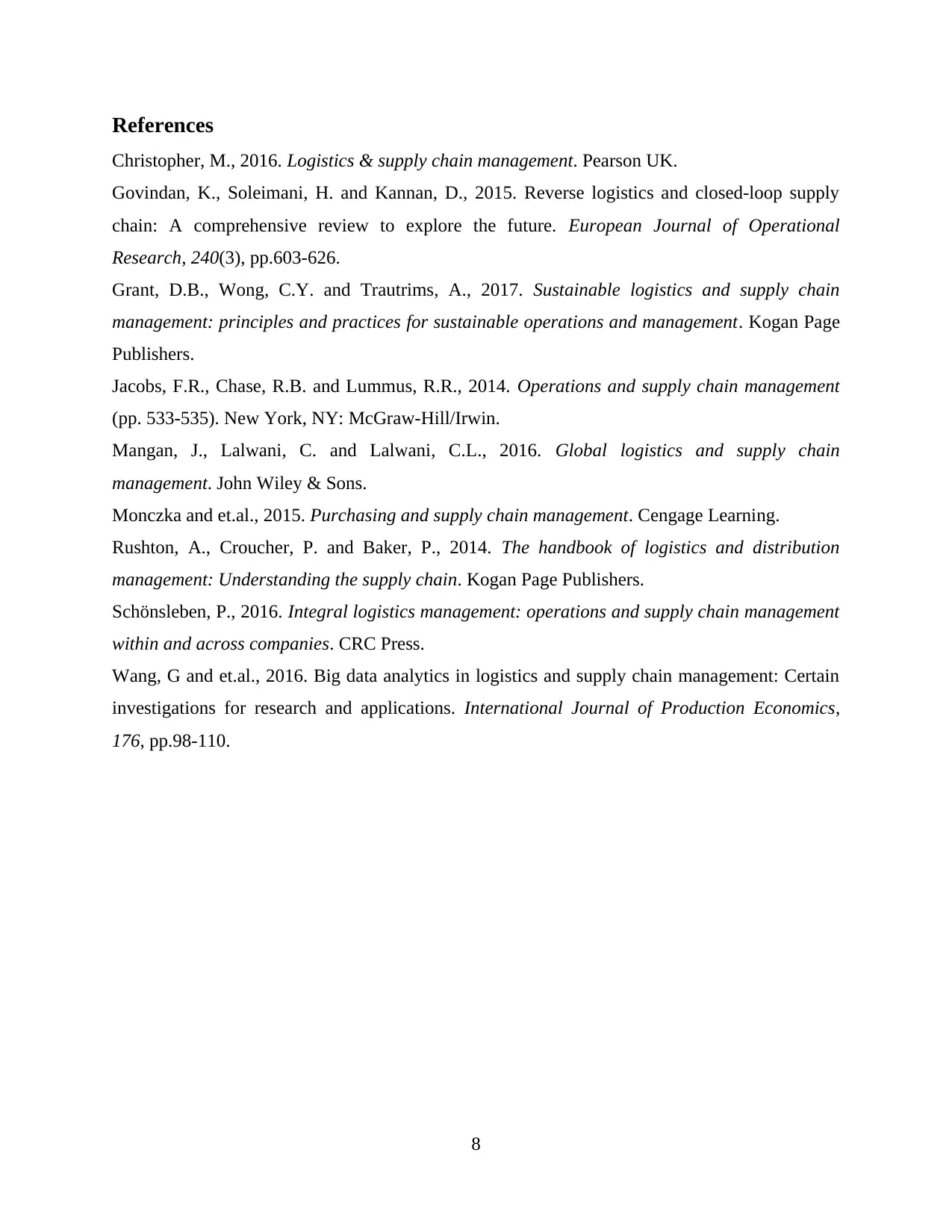
References
Christopher, M., 2016. Logistics & supply chain management. Pearson UK.
Govindan, K., Soleimani, H. and Kannan, D., 2015. Reverse logistics and closed-loop supply
chain: A comprehensive review to explore the future. European Journal of Operational
Research, 240(3), pp.603-626.
Grant, D.B., Wong, C.Y. and Trautrims, A., 2017. Sustainable logistics and supply chain
management: principles and practices for sustainable operations and management. Kogan Page
Publishers.
Jacobs, F.R., Chase, R.B. and Lummus, R.R., 2014. Operations and supply chain management
(pp. 533-535). New York, NY: McGraw-Hill/Irwin.
Mangan, J., Lalwani, C. and Lalwani, C.L., 2016. Global logistics and supply chain
management. John Wiley & Sons.
Monczka and et.al., 2015. Purchasing and supply chain management. Cengage Learning.
Rushton, A., Croucher, P. and Baker, P., 2014. The handbook of logistics and distribution
management: Understanding the supply chain. Kogan Page Publishers.
Schönsleben, P., 2016. Integral logistics management: operations and supply chain management
within and across companies. CRC Press.
Wang, G and et.al., 2016. Big data analytics in logistics and supply chain management: Certain
investigations for research and applications. International Journal of Production Economics,
176, pp.98-110.
8
Christopher, M., 2016. Logistics & supply chain management. Pearson UK.
Govindan, K., Soleimani, H. and Kannan, D., 2015. Reverse logistics and closed-loop supply
chain: A comprehensive review to explore the future. European Journal of Operational
Research, 240(3), pp.603-626.
Grant, D.B., Wong, C.Y. and Trautrims, A., 2017. Sustainable logistics and supply chain
management: principles and practices for sustainable operations and management. Kogan Page
Publishers.
Jacobs, F.R., Chase, R.B. and Lummus, R.R., 2014. Operations and supply chain management
(pp. 533-535). New York, NY: McGraw-Hill/Irwin.
Mangan, J., Lalwani, C. and Lalwani, C.L., 2016. Global logistics and supply chain
management. John Wiley & Sons.
Monczka and et.al., 2015. Purchasing and supply chain management. Cengage Learning.
Rushton, A., Croucher, P. and Baker, P., 2014. The handbook of logistics and distribution
management: Understanding the supply chain. Kogan Page Publishers.
Schönsleben, P., 2016. Integral logistics management: operations and supply chain management
within and across companies. CRC Press.
Wang, G and et.al., 2016. Big data analytics in logistics and supply chain management: Certain
investigations for research and applications. International Journal of Production Economics,
176, pp.98-110.
8
1 out of 10
Related Documents
Your All-in-One AI-Powered Toolkit for Academic Success.
+13062052269
info@desklib.com
Available 24*7 on WhatsApp / Email
![[object Object]](/_next/static/media/star-bottom.7253800d.svg)
Unlock your academic potential
Copyright © 2020–2025 A2Z Services. All Rights Reserved. Developed and managed by ZUCOL.





